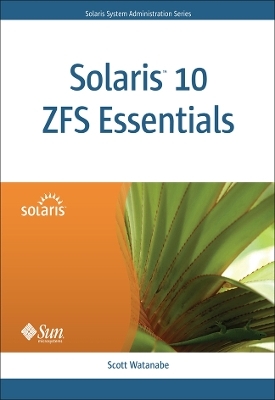
Solaris 10 ZFS Essentials
Prentice Hall (Verlag)
978-0-13-700010-4 (ISBN)
- Titel ist leider vergriffen;
keine Neuauflage - Artikel merken
In ZFS, space is shared dynamically between multiple file systems from a single storage pool and is parceled out from the pool as file systems request it. Physical storage can therefore be added to storage pools dynamically, without interrupting services. This provides new levels of flexibility, availability, and performance. Because ZFS is a 128-bit file system, its theoretical limits are truly mind-boggling–2128 bytes of storage and 264 for everything else, including file systems, snapshots, directory entries, devices, and more.
Solaris™ 10 ZFS Essentials is the perfect guide for learning how to deploy and manage ZFS file systems. If you are new to Solaris or are using ZFS for the first time, you will find it very easy to get ZFS up and running on your home system or your business IT infrastructure by following the simple instructions in this book. Then you too will understand all the benefits ZFS offers:
Rock-solid data integrity
No silent data corruption–ever
Mind-boggling scalability
Breathtaking speed
Near-zero administration
Solaris™ 10 ZFS Essentials is part of the Solaris System Administration Series and is intended for use as a full introduction and hands-on guide to Solaris ZFS.
Scott Watanabe is a freelance consultant with more than twenty-five years of experience in the computer/IT industry. Scott’s positions at Sun over the years include systems administrator, systems manager, chief architect, backline engineer, and lead course developer.
Preface ix
Acknowledgments xiii
About the Author xv
Chapter 1: Introducing ZFS File Systems 1
1.1 Overview of ZFS 1
1.2 Fast and Simple Storage 6
1.3 ZFS Commands 7
Chapter 2: Managing Storage Pools 9
2.1 ZFS Pool Concepts 9
2.2 Creating a Dynamic Stripe 11
2.3 Creating a Pool with Mirrored Devices 13
2.4 Creating a Pool with RAID-Z Devices 15
2.5 Creating a Spare in a Storage Pool 17
2.6 Adding a Spare Vdev to a Second Storage Pool 18
2.7 Replacing Bad Devices Automatically 19
2.8 Locating Disks for Replacement 22
2.9 Example of a Misconfigured Pool 23
Chapter 3: Installing and Booting a ZFS Root File System 25
3.1 Simplifying (Systems) Administration Using ZFS 25
3.2 Installing a ZFS Root File System 26
3.3 Creating a Mirrored ZFS Root Configuration 30
3.4 Testing a Mirrored ZFS Root Configuration 31
3.5 Creating a Snapshot and Recovering a ZFS Root File System 32
3.6 Managing ZFS Boot Environments with Solaris Live Upgrade 35
3.7 Managing ZFS Boot Environments (beadm) 43
3.8 Upgrading a ZFS Boot Environment (beadm) 43
3.9 Upgrading a ZFS Boot Environment (pkg) 44
3.10 References 46
Chapter 4: Managing ZFS Home Directories 47
4.1 Managing Quotas and Reservations on ZFS File Systems 47
4.1.2 The reservation and refreservation Settings 51
4.2 Enabling Compression on a ZFS File System 53
4.3 Working with ZFS Snapshots 55
4.4 Sharing ZFS Home Directories 59
4.5 References 60
Chapter 5: Exploring Zpool Advanced Concepts 61
5.1 X4500 RAID-Z2 Configuration Example 61
5.2 X4500 Mirror Configuration Example 69
5.3 X4500 Boot Mirror Alternative Example 74
5.4 ZFS and Array Storage 74
Chapter 6: Managing Solaris CIFS Server and Client 75
6.1 Installing the CIFS Server Packages 75
6.2 Configuring the SMB Server in Workgroup Mode 78
6.3 Sharing Home Directories 79
Chapter 7: Using Time Slider 83
7.1 Enabling Time Slider Snapshots 83
7.2 Enabling Nautilus Time Slider 85
7.3 Modifying the Snapshot Schedule 87
7.4 Setting the Snapshot Schedule per File System 91
Chapter 8: Creating a ZFS Lab in a Box 93
8.1 Creating Virtual Disks with Virtual Media Manager 93
8.2 Registering a CD Image with Virtual Media Manager 97
8.3 Creating a New Virtual Machine 99
8.4 Modifying the New Virtual Machine 103
8.5 Installing an OS on a Virtual Machine 106
8.6 Installing Virtual Box Tools 111
Index 119
| Erscheint lt. Verlag | 7.1.2010 |
|---|---|
| Reihe/Serie | Solaris System Administration Series |
| Verlagsort | Upper Saddle River |
| Sprache | englisch |
| Maße | 177 x 231 mm |
| Gewicht | 240 g |
| Themenwelt | Informatik ► Betriebssysteme / Server ► Unix / Linux |
| ISBN-10 | 0-13-700010-3 / 0137000103 |
| ISBN-13 | 978-0-13-700010-4 / 9780137000104 |
| Zustand | Neuware |
| Haben Sie eine Frage zum Produkt? |
aus dem Bereich


